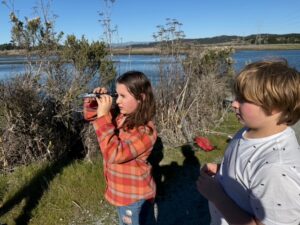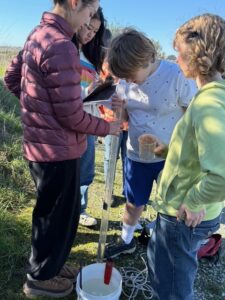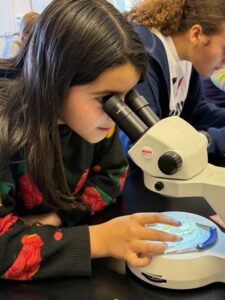 Last week, a group of Mount Madonna School (MMS) students engaged in a hands-on opportunity to learn more about the important role that the Elkhorn slough and the Elkhorn Slough Ecological Reserve play in the health of the Monterey Bay, the survival of seabirds and other marine life, such as Leatherback sea turtles.
Last week, a group of Mount Madonna School (MMS) students engaged in a hands-on opportunity to learn more about the important role that the Elkhorn slough and the Elkhorn Slough Ecological Reserve play in the health of the Monterey Bay, the survival of seabirds and other marine life, such as Leatherback sea turtles.
Trailside and from wooden piers extending over slough waters, fifth and ninth grade students – “buddy” classes which periodically collaborate on science-related topics examined food webs, looked into the slough’s benthic life, engaged in water quality testing and learned about the broader ecosystem.
 “The Elkhorn Slough field trip fits into our ninth grade biology curriculum as students study ecological principles – ecosystems, habitats, food webs, biomagnification, species relationships – and how it all fits into their lives right here where they live,” commented science teacher Nicole Silva Culbertson. “It brings to life the biology they have been learning in class. It is also a great opportunity for the ninth graders to become educators themselves, as they get to teach these concepts to the fifth graders, which enhances their own understanding.”
“The Elkhorn Slough field trip fits into our ninth grade biology curriculum as students study ecological principles – ecosystems, habitats, food webs, biomagnification, species relationships – and how it all fits into their lives right here where they live,” commented science teacher Nicole Silva Culbertson. “It brings to life the biology they have been learning in class. It is also a great opportunity for the ninth graders to become educators themselves, as they get to teach these concepts to the fifth graders, which enhances their own understanding.”
A highlight of the fifth grade experience at Mount Madonna School is a year-long, in-depth, cross-curricular project focusing on an environmental topic chosen by the students. This year, fifth graders have chosen endangered Leatherback sea turtles.
“Students had a great microscope lab looking at invertebrates and plankton in a single drop of water,” said fifth grade teacher Jessica Cambell. “There was LOTS of life in the microscope lab and students were very engaged and surprised about how  things appear magnified under a high-power microscope. Students also discovered in their single drop of water microfibers of plastic and even plankton eating the microfibers in one student’s scope!
things appear magnified under a high-power microscope. Students also discovered in their single drop of water microfibers of plastic and even plankton eating the microfibers in one student’s scope!
“For fifth grade students, this all connects to learning about the health of the slough,” continued Cambell, “as it determines the health of the ocean in general, and Leatherback are a sensitive species drastically affected by the changing health of the oceans. In addition, many of the invertebrates that Leatherbacks eat often originate in the slough as it is a ‘nursery’ habitat for many jelly fish. and other marine life.”
This field study included note taking, observation and even a brief opportunity to explore the reserve’s visitor center, however the learning highlight of the day was the macroinvertebrate lab where they could see in the microscope all of the organisms found in the slough water.
“The students yell in delight at everything they see and are often excitedly calling each other to their microscopes to see what they have found,” said Silva Culbertson. “It is a great way to bring the importance of our environment to life for the students.”




